TRUTH ADDICT
What’s Missing From the NYT’s Coverage of Protests in Ukraine?
January 28, 2014 · 4 Comments
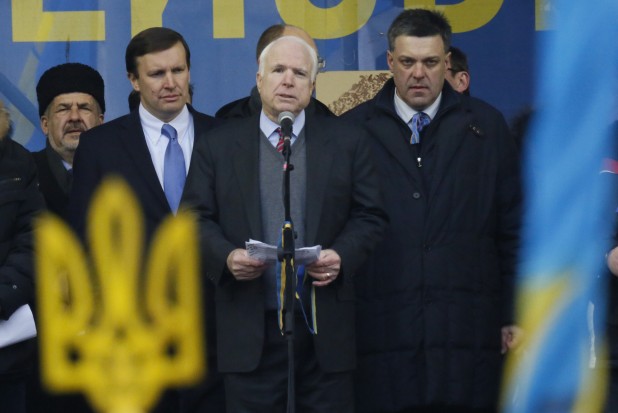
Above: U.S. Senator John McCain in Kiev, Ukraine, Dec. 14, 2013. (Photo - AP)
By Michael M'Gehee:
The protests in Ukraine, which erupted in late November 2013 following President Viktor Yanukovich’s rejection of a European trade agreement, have received a considerable amount of news coverage around the world, including from the New York Times. As usual, for the NYT and many other news outlets, it is what is buried, or not being said, that is of importance when understanding what is going on. While the image commonly depicted is that of a popular rebellion rising up against corruption and tough economic times, as the Washington Post's Max Fisher recently portrayed in his piece "Ukraine’s protests are back. Here’s why.," the truth is a little bit more complicated.
Since the protests began, more than 750 NYT articles have mentioned “Ukraine protests.” Only 12 articles (1, 2, 3, 4, 5, 6, 7, 8, 9, 10, 11 and 12) have also mentioned the “Svoboda” party, an ultra-rightwing nationalist party with historical ties to fascism, white supremacists, and neo-Nazis—and who are at the forefront of the protests and violent clashes with police.
In Article 1, Oleh Kotsyuba, who the NYT notes is a “doctoral candidate in Slavic languages and literature at Harvard and the online editor of Krytyka, an intellectual journal in Ukraine,” pens an op-ed piece that tells us how, “On Nov. 21, summoned by a Facebook post by a journalist named Mustafa Nayem, more than 1,500 Ukrainians showed up in Independence Square in Kiev to protest their government's decision to “pause” preparations for signing an association agreement with the European Union.” As well, Kotsyuba writes that, “Svoboda, whose nationalist, xenophobic, anti-intellectual and homophobic messages have frustrated European-minded Ukrainians in the past — were embedded in the protests early on.”
Judging by the images of the protests throughout the uprising, the word “embedded” may be a bit of an understatement. The blue and yellow flags of Svoboda are a dominating presence. This shows in Article 2, with some of the images the NYT published, and which it is noted that among other rightwing political parties, “Oleg Tyagnibok of the nationalist Svoboda Party, are leading the protest movement in partnership with a coalition of civic activists.”
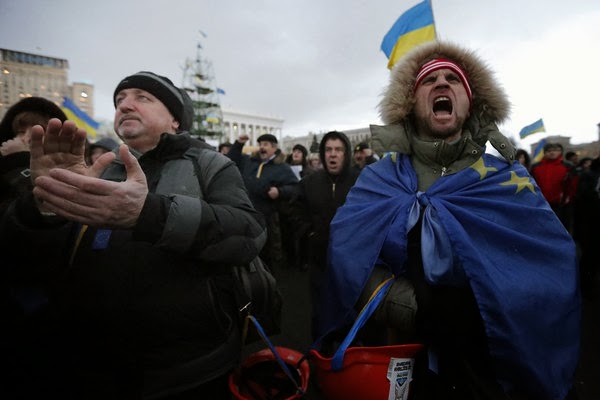 |
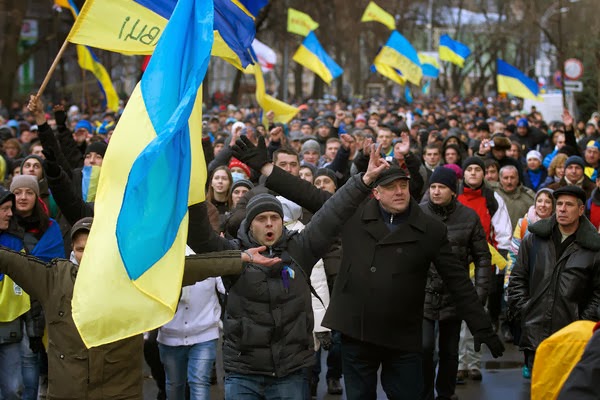 |
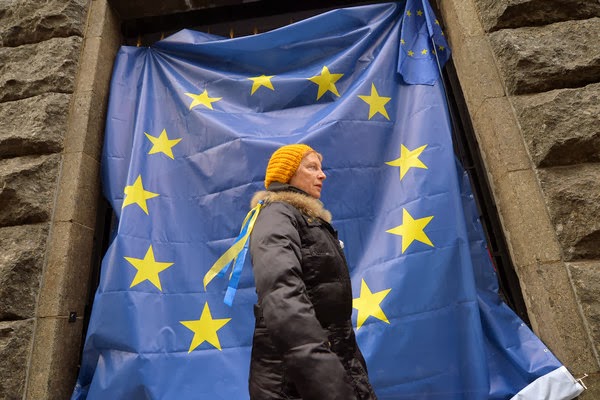 |
Article 3 briefly mentions Svoboda when the article quotes a party official as saying, “It’s a war of attrition,” and, “Whoever gives up first, loses.”
Like its predecessor, Article 4 glosses over Svoboda, though it does mention that “foreign diplomats […] have used the occasion of the ministerial conference to meet with opposition leaders,” which included “Oleg Tyagnybok, the leader of the nationalist Svoboda Party.” The “senior American official” mentioned in the story is not named.
And like Article 2, the accompanying photo for the fourth article includes the blue and yellow colors of the infamous nationalist party:
In Article 5 we read about how Svoboda toppled a statue of Lenin in early December 2013, though the article does not give credit to the party. It has, however, come forward to proudly take responsibility, which Article 6 does note.
Article 7 comes nearly a month into the uprising and is the first article to provide any historical and political context to the Svoboda party. NYT’s Andrew Kramer writes that, “The party traces its roots to the Ukrainian partisan army of World War II, which was loosely allied with Nazi Germany,” and that, “Until 2004, Svoboda had been called the Social-Nationalist Party, which critics said was just a word flip away from its true ambitions and a deliberate reference to the National Socialism of the Nazis. Unabashed neo-Nazis still populate its ranks, organizations that study hate groups in Europe say.”
Article 8 is a letter from Mark Levin, the director of a Jewish group in Washington DC, warning of the anti-semitism and xenophobia of the Svoboda party, but fails to recognize that Svoboda is a driving force behind the same uprisings Levin supports.
A month of silence on Svoboda goes by when Kramer picks back up with Article 9, only to quote a Svoboda party official as blaming the government for provoking the conflict. It is not until the following day in Article 10 where it is noted that “Protests Turn Deadly,” and that Svoboda’s “followers have been among the most aggressive demonstrators.”
Article 11 mentions the party in the context of “howls of dismay among some of the protesters gathered to listen to the two leaders, the former boxing champion, Vitali Klitschko, who leads a party called the Ukrainian Democratic Alliance for Reform, and Oleg Tyagnibok, the head of the nationalist party Svoboda."
It is the final article that informs readers: “some of the most aggressive demonstrators are supporters of the nationalist Svoboda Party and its leader, Oleg Tyagnibok.”
There is more. Also largely obscured in the NYT coverage of Svoboda is the fact that US Senator and former presidential candidate John McCain traveled to Ukraine in December to address the protesters and to meet with Svoboda leader Oleg Tyagnibok. While the NYT did manage to reference the senators trip to Kiev, where he met with President Yanukovich, in two articles (1 and 2), and in an opinion piece that referenced his having addressed the protesters, not one article mentions Senator McCain having met with opposition leaders, particularly Tyagnibok, the leader of Svoboda. While some in the NYT may think McCain's meeting with the leader of a party whose ranks the NYT has acknowledged is populated with "unabashed neo-Nazis" was not newsworthy, we at the NYTX, however, do think this was newsworthy.
In more than 750 articles published at the New York Times since the protests began in late-November there have only been 12 articles that mentioned "Svoboda," the Nazi-linked political party at the forefront of the protests. Only 1 out of 750+ provided historical and political context to this violent party of fascists. None mentioned that Senator John McCain traveled to Ukraine last month to speak to their leader, Oleg Tyagnibok, and to address a protest with Tyagnibok by his side, as he gave affirmation of support. The only other two articles that hint at the unsavory politics of Svoboda, an op-ed and letter, barely provides pertinent information.
The only other extensive coverage the NYT has provided on the party comes a year before the uprising. In November 2012, in the article “Ukraine’s Ultranationalists Show Surprising Strength at Polls,” we read about how “Oleg Tyagnibok was a member of Ukraine’s Parliament, his colleagues kicked him out over a fiery speech in which he described how Ukrainians, during World War II, bravely fought Muscovites, Germans, Jews ‘and other scum,’ and then used slurs to refer to the ‘Jewish-Russian mafia, which rules in Ukraine.’ ”
While Mr. Tyagnibok is giving space to deny his critics complaints and concerns, and to say that “Svoboda is simply and only a pro-Ukrainian party. And that’s it,” the NYT article shoots back: “Of course, that was not it.”
The article warns that Mr. Tyagnibok “has used his party’s pro-Ukrainian message to tap into frustration over the country’s stalled economy and growing disillusionment,” and that, “Researchers who specialize in extremism say it is a talent shared by other leaders of far-right parties and has helped bring them into the mainstream in many European countries, including Hungary, Poland and Romania.” Talk about foreshadowing.
That kind of context, which shows the NYT can deliver it, has been missing to a considerable degree in a time when it is most needed: now.
UK’s Channel 4 News, on the other hand, and as a comparison, has not dropped the ball.
In two articles they have managed to provide the kind of context the NYT has failed to give.
In the middle of December Channel 4 reported that “Far-right group at heart of Ukraine protests meet US senator.” The article says that, "Protests continue in the Ukrainian capital after an endorsement from US Senator John McCain but at the heart of the movement in Kiev lies an extreme right wing party with links to the BNP." On Svoboda, Channel 4 informs their readers that, "The party was registered in 1995, initially called the Social National Party of Ukraine and using a swastika style logo."
And then again this month with their recent piece, “Ukraine: far-right extremists at core of 'democracy' protest,” the British news agency says that "the Svoboda party [is] assuming a leading role in the movement and paramilitary groups leading the street fighting."
Channel 4 is not alone. The oldest published weekly magazine in the US, The Nation, recently reported on "The Ukrainian Nationalism at the Heart of ‘Euromaidan'." Moscow-based journalist Alec Luhn writes that, "Protest coverage focused on the call for European integration and the struggle against the Yanukovich regime has largely glossed over the rise in nationalist rhetoric, often chauvinist, that has led to violence not just against police, but also against left-wing activists."
Ukraine's democratically-elected leader has pulled back from a trade agreement with the EU, which Europe and the US are upset about. This provoked an angry and violent response by right-wing opposition parties—a considerable presence of which has included neo-Nazi ultra-nationalists who want nationalities listed on passports—with links to the West. They are trying to bring down the government. The most recent coverage is that of the Yanukovich government offering a power sharing agreement, to which the opposition rejects.
Before the world relies on mainstream media coverage to cheerlead a revolution, which Forbes magazine is now openly calling for the West to intervene to help see through (and notice they don’t bother to even mention Svoboda or their politics while shedding crocodile tears for the fate of Ukraine), perhaps we should look to see who is at the heart of the uprising in Kiev, who would likely fill the vacuum, and ask: Is a trade agreement with the West worth the re-emergence of fascism in Europe?
UPDATE (1/30/2014) : This article has been edited to further clarify and emphasize that while the NYT does not consider McCain's meeting with Svoboda leader Oleg Tyagnibok to be newsworthy, NYTX does.
By admin
Readers Comments (4)
Sorry, comments are closed on this post.



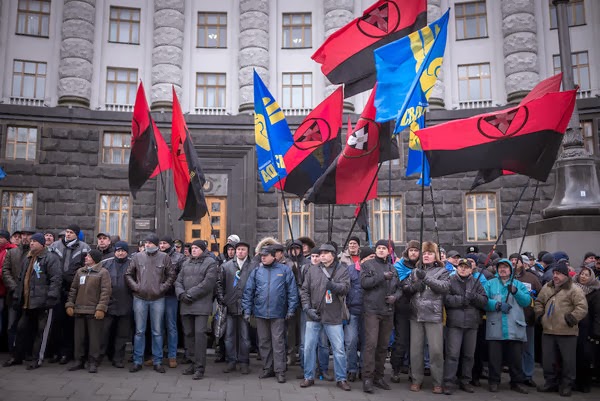
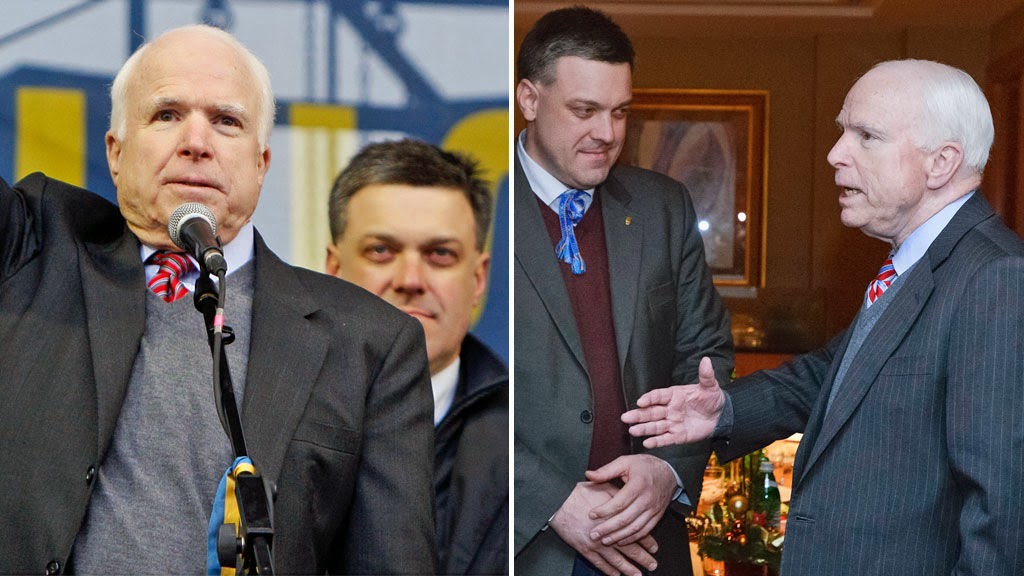




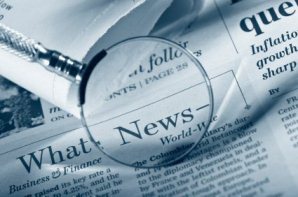
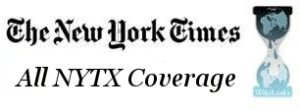
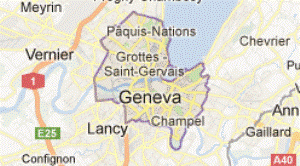
I don’t get it. So between November 21, 2013 when the protests began and January 28th 2014, when you wrote the article, the NYT was writing an average of 11 articles per day regarding the Ukraine protests? Where are you getting your numbers? They sound entirely cherry picked or just flat-out made up.
…NYT missed the scoop while other news media did not. Focusing on the NYT search results, which is a mess as the author seems to have searched for “Ukraine protests” in NYT’s database since 1851 (when it starts), is a red herring. Searching the same terms from November 1 last year to today produces just 30 results. But still, the author’s claim at that time, that “not one article mentions Senator McCain having met with opposition leaders, particularly Tyagnibok, the leader of Svoboda” seems a valid observation that you should not so easily dismiss.
“The blue and yellow flags of Svoboda are a dominating presence.” A huge mistake: the blue & yellow is the flag of Ukraine!
No offense, but you need to think a little bit or educate yourself at least before saying something stupid.
True: blue and yellow are the colors of the Ukraine flag.
Also true: the 3 yellow fingers on the svoboda flag have many meanings, including Freedom.
Rewind 8-10 years ago.
1995:
The Nationalist Socialist party (name after Hitler’s party) isn’t very popular.
“What’s going on? why are we so unpopular?”
“Eh! I think I know! maybe because now, that party is associated with Nazis!”
“So?”
“So Nazism isn’t cool anymore”
“Really? Okay, so let’s call it something that people will like: how about “freedom (Svoboda) party!”
“Good idea! How about we change our logo too. We ditch the swastika and we use three fingers instead (the sign of freedom, and also ironically fascism in the past but that’s beside the point).”
“Yeah, yeah, and let’s make the hand yellow and the background blue, like the flag of Ukraine!”
“Cool, now let’s see what happens”
It’s working! We’re getting more and more popular! We now have 1 seat at the parliament!
Today:
“Wow, it really worked. Look at us now! The only Nazi country in the world, and everyone thinks we’re a democratic state , all thanks to Reuters. I bet they don’t even know we want to exterminate anything that’s got Russian blood in Ukraine [30% of the population], and we’ve got the US behind us! Just like Israel’s genocide of the Palestinians. Now we’re in business! And Putin can’t restore democracy or even help all this Russian vermin which pollutes our race. We kill them by the thousands, civilians, politicians… We can even use military forces now and it’s okay. We bomb them everyday, meanwhile Putin gets sanctions. Is he ever going to snap? Are we and our allies going to have what we want, a nice big WW3? HE does not want or need one to further his country’s economic success. He believes in civilized ways, like BRIC.”
It’s good to spread knowledge, but try you know what you’re talking about first.